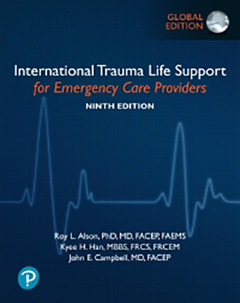Description
International Trauma Life Support for Emergency Care Providers, Global Edition (9th Ed.)
Authors: ITLS , Navarro Ann, Atkinson James
Language: English
Subject for International Trauma Life Support for Emergency Care...:
77.31 €
In Print (Delivery period: 14 days).
Add to cart520 p. · 21.6x27.4 cm · Paperback
Description
/li>Contents
/li>Comment
/li>
SECTION 1: ESSENTIAL INFORMATION
1. Introduction to Traumatic Disease
2. Trauma Assessment and Management
3. Assessment Skills
4. Hemorrhage Control and Shock
5. Shock and Hemorrhage Control Skills
6. Airway Management
7. Airway Skills
SECTION 2: FOUNDATIONAL KNOWLEDGE
8. Thoracic Trauma
9. Thoracic Trauma Skills
10. Spinal Trauma and Spinal Motion Restriction
11. Spine Management Skills
12. Head Trauma and Traumatic Brain Injury
13. Abdominal Trauma
14. Extremity Trauma
15. Extremity Trauma Skills
16. Traumatic Arrest
SECTION 3: SPECIAL POPULATIONS
17. Burns
18. Pediatric Trauma
19. Geriatric Trauma
20. Trauma in Pregnancy
21. The Impaired Patient
Appendices
A. Standard Precautions
B. Analgesia and Pain Control for the Trauma Patient
C. Multicasualty Incidents and Triage
Up-to-date guidelines and completereorganization
- The text conforms to the latest guidelines on trauma care from the American Heart Association, International Liaison Committee on Resuscitation, and Committee on Trauma of the American College of Surgeons.
- Expanded - Chapter 1 now discusses changes put forth by the Hartford Consensus with regard to scene safety and team-based, multidisciplinary trauma care.
- Expanded - Chapter 19 now examines how advancing age increases mortality and identifies it as an independent risk factor for needing trauma care.
- Revised - The text has been completely reorganized to reflect a more functional approach to the assessment and management of the trauma patient. It is now divided into four sections:
- Essential Information
- Foundational Knowledge
- Special Populations
- Appendices
Skills development
- Management skills chapters follow each didactic chapter on a clinical topic to review the essential skills needed to manage the clinical situation.
- Updated - Chapter 4 now includes updated techniques for managing hemorrhage, some of which reflect the latest experiences of the military during recent conflicts.
- Updated - Chapters 11 and 12 now incorporate the current science and evolution of when to apply spinal motion restriction based on published guidelines.
- Expanded - Chapter 13 now includes pelvic fractures, as associated with concurrent abdominal injuries.
Engaging practice opportunities andresources
- Hands-on exercises throughout the text help readers apply knowledge and skills to simulated patients.

